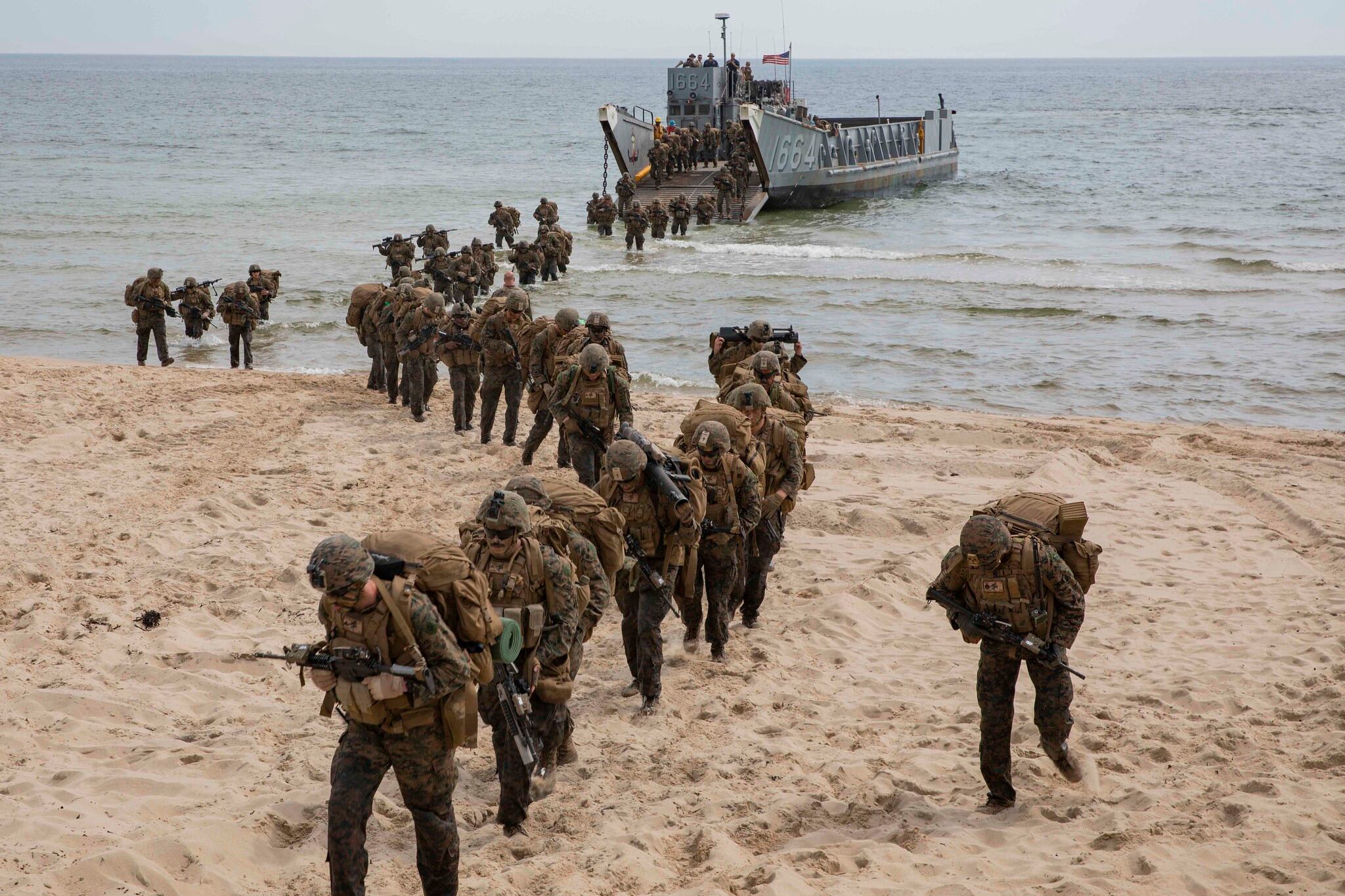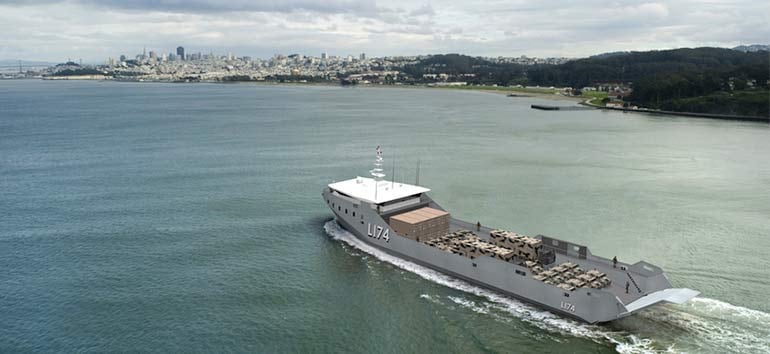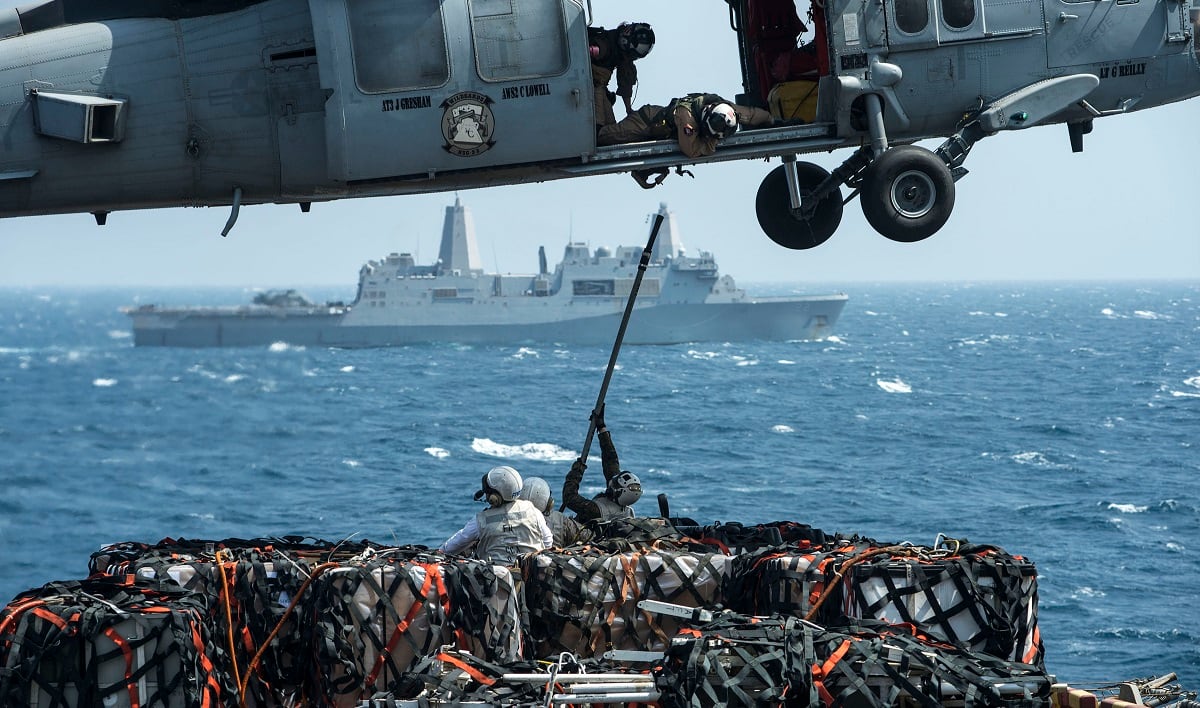Fewer Marines than in recent history have spent time aboard ship. For those who transited the world’s oceans to fight in Iraq or Afghanistan, the Navy ship they sailed on served as a kind of taxi service on the beeline to combat.
As most Marines have spent much of the past two decades in land battles, the Navy pushed its maritime priorities, leaning on deep-sea firepower and reluctantly funding a few closer-to-shore projects like the littoral combat ship, which has faced fielding, maintenance and employment woes.
But the sea services are moving ahead with a plan to get hulls in the water that may carry a new kind of Marine fighting force into the combat role it envisions for fighting against a well-armed and prepared adversary such as China.
Questions loom, however, as to whether existing ship priorities and a new ship design — the light amphibious warship — will be funded, fabricated, floating and fighting in time to keep the Corps relevant.
Lawmakers seem watchful but wary, given past big-ticket spending on ship programs that didn’t end up meeting service goals.
RELATED

And while Marine Commandant Gen. David Berger’s vision has scaled back the force size and number of brigades it would send into the fight, he and Navy counterparts are looking to new and more numerous ships to get Marines in the mix.
As equipment programs come to fruition, the Corps also will have to reconsider life on ship.
What typically has been boring — work out-eat-sleep and repeat while awaiting a liberty port or training exercise — needs to become much more active.
Marine veteran Staff Sgt. Evan McAllister, a multiple combat tour infantryman, sniper and reconnaissance Marine, and his fellow recon Marines strove to stay vigilant with their training aboard ship, which wasn’t true of some of his fellow infantry — and it showed.
“On my MEU, I watched an entire infantry battalion, which already had a serious training and physical conditioning deficit before the float even started, deteriorate into a completely mission-incapable unit,” he told Marine Corps Times.
He saw little physical training among the grunts while on ship, and even basic noncombat load outs conducting short foot marches on the beach resulted in “ragged lines of bodies strung in awkward lines on an uphill road because no squad could keep an intact formation” on a short administrative hike.
“Had it been a combat operation, it would have been a catastrophe,” he said.
To get it all right, the Marine Corps and Navy need to move fast.
New capabilities
Marine Corps Assistant Commandant Gen. Eric Smith, for the past few years, has focused his priorities on rapid delivery of new capabilities to Marines.
Ambitious plans for the light amphibious warship, still in the design phase, call for the first ship procured by 2023, along with a host of other systems, some that have been in development for years.
The light amphibious warship, the LAW, will be substantially smaller than the L-class amphibious ships it seeks to complement, and that is on purpose.
Current concepts call for a 200-foot to 400-foot ship, with a maximum draft of 12 feet and the ability to carry 3,000 tons to 4,000 tons, allowing it to skirt island shores where bigger ships can’t go, hiding in the nooks and crannies of the hundreds of islands in the South China Sea.

Those smaller ships would carry an equally diminutive but no less deadly force of up to 75 Marines and a crew of about 40 sailors. The roughly two-platoon’s worth of Marines, filled with salty enlisted infantry carrying high-tech weaponry and sensors, would hit the shore to set up expedient positions, launch devastating strikes with a vehicle-mounted missile system, the Navy Marine Corps expeditionary ship interdiction system, or NMESIS, to sink enemy ships.
The two platoons would then reboard their small warship and slide off to another hiding place, awaiting another opportunity to strike.
The Marines wouldn’t necessarily be alone. The way Berger sees it, the light amphibious warship would work in tandem with the more power-packing L-class ships.
Also known as amphibs, examples include the landing ships with docks or well decks or landing platform/docks with their ship-to-shore connectors or the air asset focused helicopter deck landing ships, or LHAs, a kind of mini-aircraft carrier. Both of which are more than four times the length of the light amphibious warship and can carry many times the load.
Both ship types are needed to do the job, Berger and top Marine officials both echoed at the National Defense Industrial Association’s annual expeditionary warfare conference in early February.
“They are not a substitute for each other because a traditional amphibious ship has all the attributes that we know and love so much over the years that a Marine expeditionary unit and amphibious ready group have been using,” Berger said.
The larger amphibs bring the whole kit to the scene, able to conduct wartime operations but also provide a floating hospital, evacuation and other attributes for humanitarian assistance.
The light amphibious warship fills gaps between the larger amphibs and the ship-to-shore connectors, such as the landing craft utility and the landing craft air cushion, which have limited range and few defenses, Lt. Gen. Karsten Heckl, head of the Corp’s combat development command, said at the conference.
In late 2020, Maj. Gen. Tracy King, then-director of expeditionary warfare, said that the light amphibious warship was, “perhaps the most important investment the Marine Corps was making to optimize itself for expeditionary advance base operations.”
That is the war fighting concept by which Berger and others see the Corps inserting small teams of well-armed Marines across the battle space to enable Navy sea control and sea denial.
To make it work, the generals want a lot of light warships.
Numbers matter
The Navy’s stated goal, until recently, has been a fleet of 355 ships.
For years the Corps held firm that it needed 38 amphib ships in that fleet to move two Marine brigades into theater and fight the big fight. Such a brigade would include roughly 15,000 Marines and associated equipment.
But starting with his first major document, a planning guidance released shortly after taking the post, Berger signaled willingness to sacrifice some assets to make the Corps nimbler and more relevant. Ditching heavy armor such as tanks, moving artillery toward rocket fire and away from conventional, short-range assets were the first marks.
Over time the Corps change its tune, instead shifting to an amphib-ship inventory that would at least support a single Marine brigade going to war. To make up the difference, the Corps sees light warships in the mix.

The 38-amphib ship demand has been cut down to between 28–31 ships. Specifically 10 “big deck” mix of LHAs and LHDs and another 21 LSD and LPD mix, according to statements by Smith and others.
But with fewer big amphibs comes more small ships. The Marines want 35 light amphibious warships at a total estimated cost of around $4.6 billion, roughly $130 million each, after initial production.
A single amphib can cost more than $3 billion, according to budget documents. At those numbers, for the cost of less than two amphibs, the Corps could get nearly three dozen light warships.
President Joe Biden’s administration has paired somewhat with the Marine shift, within a range.
The president’s plan calls for a total amphib fleet, both large and small, at 48 to 63 ships. That would include eight to nine LHA/LHDs; 16 to 19 LPDs and 24 to 35 light amphibious warships, according to budget documents.
The Corps’ wish list of 35 light amphibious warships would provide nine of them for each of the three Marine littoral regiments and eight more to cushion operational demands and maintenance requirements.
Just having a few more ships, being smaller, would change training for a whole lot of Marines.
In 2018 there were not enough ships for Marines to even train at the brigade level, let alone deploy, Marine Corps Times reported. Then deputy commandant for plans, policies and operations, Lt. Gen. Brian Beaudreault, told Congress the ability simply didn’t exist with the available ship inventory.
The Navy couldn’t fill 93%, or 294 out of 314, of Marine requests for amphibious training on the West Coast. Nearly half of the East Coast requests went unfilled, according to a Government Accountability Office report.
Life on ship
The Marine littoral regiment is the formation being built for this new method of fighting and the primary passengers aboard the future light amphibious warship.
On March 3 the 3rd Marine Regiment in Hawaii was redesignated as the 3rd Marine Littoral Regiment. The estimated 7,500-Marine unit may not be fully operational for a few years, but it’s the direction the Corps is headed.
The Corps will still deploy its Marine expeditionary units, the moneymaker of the Marine enterprise in day-to-day force projections, floating across the globe with a combined arms package of air-land-sea assets. But the fire-focused infantry set of the Marine littoral regiment is what the Corps is going to put on board the light amphibious warships and send to war.
For successful war fighting at the small unit level, Smith pointed to the NMESIS, the MQ-9A reaper drone, the ground/air task oriented radar, or G/ATOR, and long range unmanned surface vessels.
The strike missile provides firepower, the drone provides strike, sensing and targeting, the radar gives Marines awareness and detection and the unmanned vessels give Marines resupply on far-flung outposts.
If planning, testing and fielding are in lockstep, those four capabilities will be available, in limited form, by 2023, Smith said.
But leathernecks aren’t waiting for combat-ready gear to arrive at the loading docks.
They’ve got the G/ATOR already as well as recent MQ-9A drones. Marines in Hawaii and California are doing experiments with the NMESIS and, as they await a seaworthy unmanned surface vessel, they’ve been experimenting with 33-foot rigid-hull inflatable boats and the 45-foot metal shark boat, a coastal patrol boat commonly used for shoreline defense.
Staff Sgt. Patrick Garcia, who works in motor vehicle maintenance, has had multiple ship deployments in his more than 10 years of service. He and his fellow technicians keep busy with maintaining the vehicle fleet aboard ship.
One of the more cumbersome tasks though remains loading and offloading vehicles and equipment from the bigger amphibs to shore connectors such as LCACs, he said.
If equipment as the joint light tactical vehicle, part of the NMESIS package, are loaded and ready on the light amphibious warships with their planned-for drop ramps, Garcia said mobility could be better for quick offloading and reloading as ships move around theater.
In some ways, he said, being aboard a smaller ship would give Marines more chances to go ashore, a welcome relief the rigors of ship life, having been aboard amphibs that could stay out to sea for months at a time.
“You’d keep your sanity a lot more if you did that,” Garcia joked.
Aboard the smaller ships, Marines may have other noncombat duties.
While Marines likely won’t be attending full-blown Navy job schools for ship maintenance and disaster response, they easily could be pressed into “bucket brigades” to fight shipboard fires or locking off areas if the ship takes a hit, said Dakota Wood, retired Marine lieutenant colonel and senior research fellow with The Heritage Foundation conservative think tank in Washington.
A cautionary tale
While there’s more alignment now between the Navy, Marine Corps and presidential administration on shared ship goals, a still-going program casts its own shadow on shipbuilding efforts.
The littoral combat ship once was hailed as the solution to close-to-shore fighting and central to an ambitious plan to revamp that gap in sea power.
Navy estimates show it will cost $60 billion to operate and support the planned-for 35 littoral combat ships, a February Government Accountability Office report noted. That number is nearly double the amount estimated in 2011 of $38 billion. And it includes the 17 already built and delivered.
Since 2005 the Government Accountability Office has provided at least 19 reports highlighting deficiencies, maintenance, manning and operational problems with the littoral combat ship program. That year the original fleet goal was between 63 and 82 ships.
A key lesson of the littoral combat ship program for Marines is “don’t fall in love with your concept,” according to Mark Cancian, a retired Marine colonel and now senior adviser with the Center for Strategic and International Studies in Washington.
The littoral combat ship promised to deliver a hull capable of littoral combat and a host of other missions, with “modules” swapped in and out of ships for specific mission packages. The cost, operation and reliability of those promised modules have plagued the program.
“Build a few (light amphibious warships) and experiment with them before you go into a radically new concept,” Cancian said. “I think you have to be very careful before you commit to a large class of ships.”
Should the funding come through for both platforms at the levels Marines want, the impasses that have kept the Navy and Marine Corps at odds for decades might finally be resolved. But if not, the Corps’ war fighting plan could be in jeopardy.
“I think the Marine Corps is operating at risk,” Wood said. “But it seems reasonable to recognize if (Berger) waits for the other services to get their act together then nothing will ever get done.”
Editor’s note: This article has been updated to correctly reflect the rank of Gen. Eric Smith.
Todd South has written about crime, courts, government and the military for multiple publications since 2004 and was named a 2014 Pulitzer finalist for a co-written project on witness intimidation. Todd is a Marine veteran of the Iraq War.




